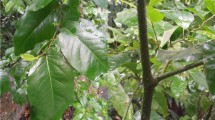Abstract
The purpose of this study was to isolate an active constituent from the essential oil of Eugenia caryophyllata leaves and to evaluate its insecticidal activity against the nymph and adults of Pochazia shantungensis. According to some chromatographic methods and spectroscopic analyses, the active constituent of E. caryophyllata leaves was identified as eugenol. Based on the LC50 values of eugenol and its structural analogues against the nymph and adults of P. shantungensis, isoeugenol (LC50, 83.29 and 91.03 mg/L) exhibited the highest insecticidal activity, followed by methyl isoeugenol (105.61 and 114.48 mg/L), eugenol (124.44 and 143.24 mg/L), methyl eugenol (126.31 and 143.84 mg/L), and acetyl eugenol (165.11 and 170.06 mg/L). Insecticidal activity against P. shantungensis was dependent on the presence of a functional group in 4-ally-2-methoxyphenol. In conclusion, E. caryophyllata oil and eugenol analogues might be suitable alternative synthetic insecticides.

Similar content being viewed by others
References
Ahn KS, Lee GS, Lee KH, Song MK, Lim SC, Kim GH (2011) Susceptibility commercially of North American planthopper, Metcalfa pruinosa to commercially registered insecticides in Korea. Korean J Pest Sci 15:329–334
Batish DR, Singh HP, Kohli RK, Kaur S (2008) Eucalyptus essential oil as a natural pesticide. For Ecol Manag 256:2166–2174
Chaieb K, Hajlaoui H, Zmantar T, Kahla-Nakbi AB, Rouabhia M, Mahdouani K, Bakhrouf A (2007) The chemical composition and biological activity of clove essential oil, Eugenia caryophyllata (Syzigium aromaticum L. Myrtaceae): a short review. Phytother Res 21:501–506
Cho IH (2015) Volatile compounds of ginseng (Panax sp.): a review. J Korean Soc Appl Biol Chem 58:67–75
Cho JH, Lee CH, Son DJ, Park YH, Lee HS (2004) Antiplatelet activity of phenylpropanoids isolated from Eugenia caryophyllata leaf oil. Food Sci Biotechnol 13:315–317
Choi YS, Hwang IS, Kang TJ, Lim JR, Choe KR (2011) Oviposition characteristics of Ricania sp. (Homoptera: Ricaniidae), a new fruit pest. Korean J Appl Entomol 50:367–372
Choi DS, Kim DI, Ko SJ, Kang BR, Lee KS, Park JD, Choi KJ (2012) Occurrence ecology of Ricania sp. (Hemiptera: Ricaniidae) and selection of environmental friendly agricultural materials for control. Korean J Appl Entomol 51:141–148
Cuthbertson AGS, Blackburn LF, Northing P, Luo W, Cannon RJC, Walters KF (2009) Leaf dipping as an environmental screening measure to test chemical efficacy against Bemisia tabaci on poinsettia plants. Int J Environ Sci Technol 6:347–352
Duguet JS, Quan L (1990) Evaluation of the effectiveness of deltamethrin spray or dust on rice husks against stored products pests on stored rice in southern of China. Agric Trop 45:107–113
Dzamic A, Sokovic M, Ristic MS, Grijic-Jovanovic S, Vukojevic J, Marin PD (2009) Chemical composition and antifungal activity of Illicium verum and Eugenia caryophyllata essential oils. Chem Nat Compd 45:259–261
Houghton JT, Ding Y, Griggs DJ, Noguer M, Van Der Linden PJ, Xiaosu D, Maskell K, Johnson CA (2001) Climate change 2001: the scientific basis. Cambridge University Press, Cambridge
Kim MG, Yang JY, Lee HS (2013) Acaricidal potentials of active properties isolated from Cynanchum paniculatum and acaricidal changes by introducing functional radicals. J Agric Food Chem 61:7568–7573
Kim DY, Kim SH, Ahn HM, Lim SR, Oh JS, Choi SG, Le HJ, Auh JH, Choi HK (2015) Differentiation of highbush blueberry (Vaccinium corymbosum L.) fruit cultivars by GC–MS-based metabolic profiling. J Korean Soc Appl Biol Chem 58:21–28
Lee HW, Lee HS (2015) Acaricidal potency of active constituent isolated from Mentha piperita and its structural analogs against pyroglyphid mites. J Korean Soc Appl Biol Chem 58:597–602
Shin YH, Moon SR, Yoon CM, Ahn KS, Kim GH (2010) Insecticidal activity of 26 insecticides against eggs and nymphs of Lycorma delicatula (Hemiptera: Fulgoridae). Korean J Pest Sci 14:157–163
Sigma-Aldrich (2010) In material safety data sheet (MSDS): toxicological information, section 11. Sigma-Aldrich, St Louis
Song JS, Lee CM, Lee DW (2013) Leaf damage symptom of grape (Vitis vinifera) by tea bagworm (Eumeta minuscula) and control efficacies of several insecticides against the Eumeta minuscula. Korean J Pest Sci 17:27–32
Sung BK, Lee CH, Kim CH, Son JS, Lee HS (2004) Antimite effect of essential oils derived from 24 Rosaceae and Umbelliferae species against stored food mite. Food Sci Biotechnol 13:512–515
White NDG, Leesch JG (1995) Chemical control, in integrated management of insects in stored products, New York, USA, pp. 287–330
Yang JY, Lee HS (2012) Acaricidal activities of the active component of Lycopus lucidus oil and its derivatives against house dust and stored food mites (Arachnida: Acari). Pest Manag Sci 68:564–572
Yoo CB, Han KT, Cho KS, Ha J, Park HJ, Nam JH, Lee KT (2005) Eugenol isolated from the essential oil of Eugenia caryophyllata induces a reactive oxygen species-mediated apoptosis in HL-60 human promyelocytic leukemia cells. Cancer Lett 225:41–52
Zettler JL, Arthur FH (2000) Chemical control of stored product insects with fumigants and residual treatments. Crop Prot 19:577–582
Acknowledgments
This work was carried out with the support of “Cooperative Research Program for Agriculture Science & Technology Development (Project title: Study on the ecology and development of management practice for an exotic and epidemic pest, Ricania sp., Project No. PJ0116902016)” Rural Development Administration, Republic of Korea.
Author information
Authors and Affiliations
Corresponding author
Rights and permissions
About this article
Cite this article
Lee, HW., Lee, SG. & Lee, HS. Active component isolated from Eugenia caryophyllata leaves and its structural analogues show insecticidal properties against Pochazia shantungensis . Appl Biol Chem 59, 609–614 (2016). https://doi.org/10.1007/s13765-016-0200-9
Received:
Accepted:
Published:
Issue Date:
DOI: https://doi.org/10.1007/s13765-016-0200-9




